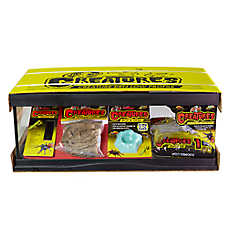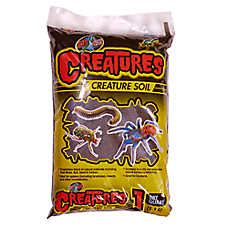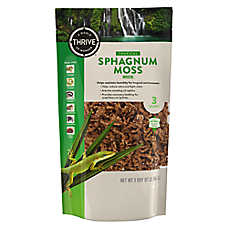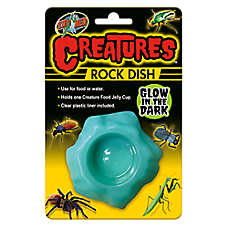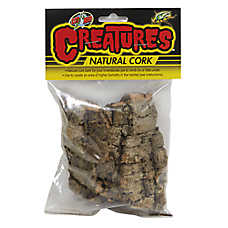Scorpion and Tarantula Digital Care Guide
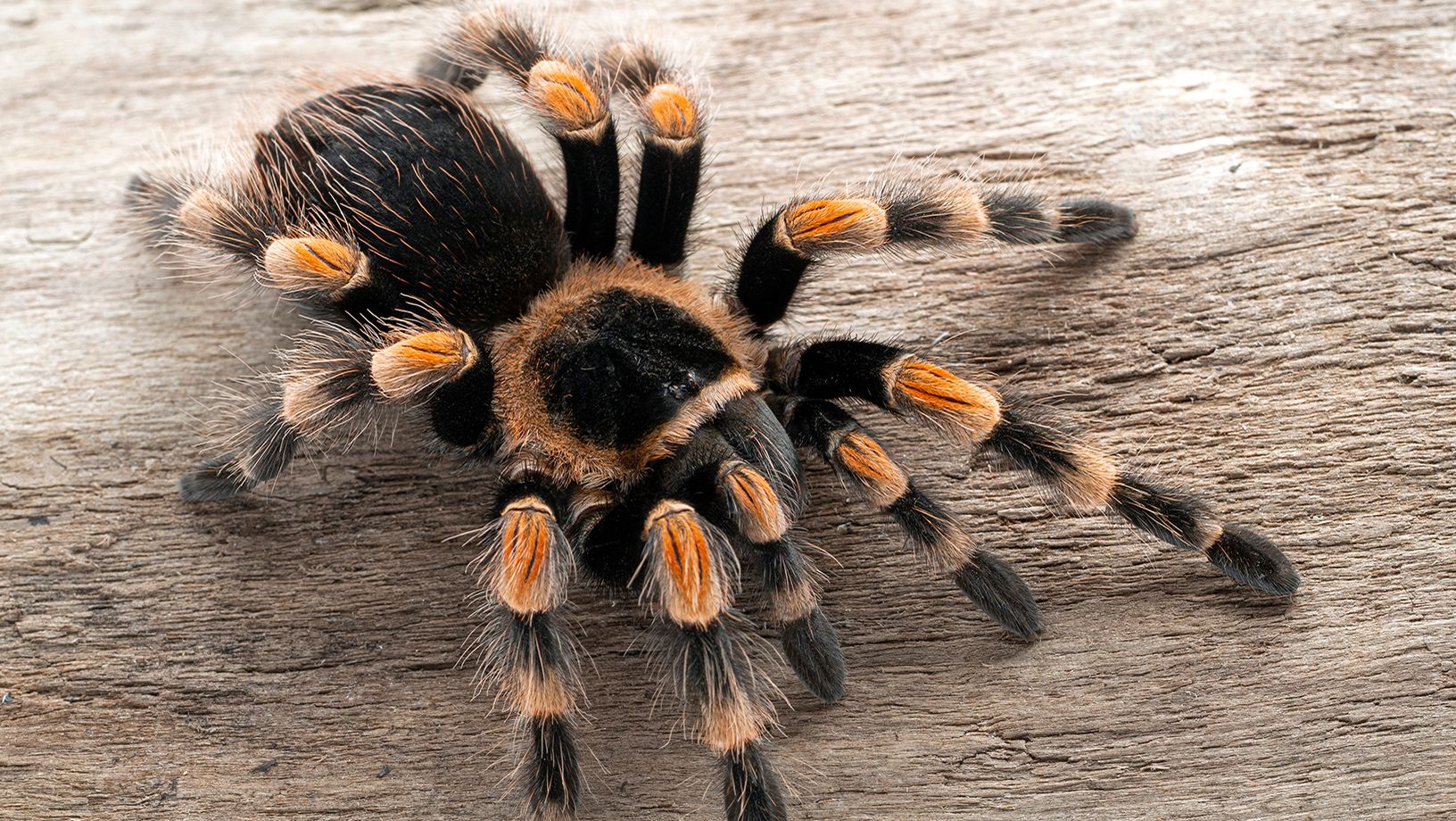
In this Article
- Crawling Right Into Your Heart, Scorpions & Tarantulas!
- Setting up a habitat for your scorpion or tarantula
- Enclosure size and type
- Substrate and humidity control
- Temperature regulation
- Feeding and molting in scorpions and tarantulas
- What to feed scorpions and tarantulas
- Feeding tips
- Water and hydration
- Understanding molting
- SHOPPING CHECKLIST
- FAQs
Crawling Right Into Your Heart, Scorpions & Tarantulas!
While not everyone’s favorite, arachnids like scorpions and tarantulas can make excellent pets. They’re not loud, don’t need to go on walks, and won’t chew up any of your possessions! Tarantulas can live a good long life, and with some patience they can become accustomed to being held and interacted with. Scorpions are less likely to want to be handled but are just as fascinating to observe and care for. While vastly different from more “traditional” pets, arachnids like scorpions and tarantulas can have quirks and personalities just like our furry and feathery friends, and they are just as deserving of love as any other animal.
Tarantula and scorpion pet profile:
Experience level: Beginner – intermediate (dependent on species)
Size: Scorpions: 6-8" (10-15 cm); tarantulas: 4-6" (15-20cm)
Lifespan: Scorpions: 5-8 years; tarantulas: 4-20 years
Habitat: They can be found in desert, temperate or tropical environments (dependent on species)
Behavior: Solitary and independent for the most part
Despite their simple appearance, many arachnids display complex behavior. Tarantulas often seal off their hide or stop eating in preparation for a molt. Scorpions may show defensive posturing or avoid movement when exposed to vibration or light. Learning to recognize these behaviors helps reduce stress and support your animal’s natural instincts.
Note: Always research the specific species you plan to keep. Even closely related species may require different humidity levels, hiding structures, or substrate depths.
Setting up a habitat for your scorpion or tarantula
Proper habitat setup is essential for supporting the long-term health and natural behavior of arachnids. Each species requires specific humidity levels, secure hiding areas, and controlled temperature gradients. While most housing requirements are similar, fine-tuning conditions to the species' native environment will improve your animal’s comfort and reduce stress-related behaviors.
Enclosure size and type
A secure glass or plastic terrarium between 5 and 10 gallons in volume is generally appropriate. The enclosure should be at least 12 to 20 inches tall to allow for climbing décor and vertical webbing. Avoid overly large enclosures for terrestrial tarantulas, as this may increase the risk of injury from falls. Always use a tight-fitting screen lid to allow for airflow while preventing escape. Scorpions are strong and capable of lifting unsecured lids. Tarantulas may attempt to climb or push through even narrow gaps.
Substrate and humidity control
Line the base of the enclosure with 2 to 3 inches of substrate. Most species do well with a blend of coconut fiber, sphagnum moss, bark chips, and sand, adjusted to suit their humidity needs.
- Replace substrate completely once a month
- Spot clean regularly to remove waste or uneaten prey
- Avoid cedar or pine-based substrates, which can be toxic
For humidity control, mist the enclosure lightly as needed, always away from the animal. Never spray directly on your tarantula or scorpion. Use a digital hygrometer to monitor levels consistently. Do not over-mist. Excess moisture can cause respiratory issues or encourage mold growth. Always maintain good ventilation.
Temperature regulation
Scorpions and tarantulas are ectothermic and require external heat to regulate bodily functions. Each enclosure should offer a temperature gradient, allowing the animal to move between warmer and cooler areas as needed.
- Use a low-wattage heat bulb or ceramic heat emitter
- Position the heat source above or to the side, never beneath the enclosure
- Turn heat elements off at night to maintain a healthy day-night cycle
- Always monitor temperatures using accurate thermometers on both sides of the habitat
Ideal environmental conditions:
Species | Temperature Range | Humidity Range |
Emperor & Asian Forest Scorpions | 70 to 80°F (21 to 27°C) | 70% to 80% |
Pink Toe & Curly Hair Tarantulas | 70 to 80°F (21 to 27°C) | 70% to 90% |
Striped Knee & Mexican Red Knee | 70 to 80°F (21 to 27°C) | 30% to 70% |
Feeding and molting in scorpions and tarantulas
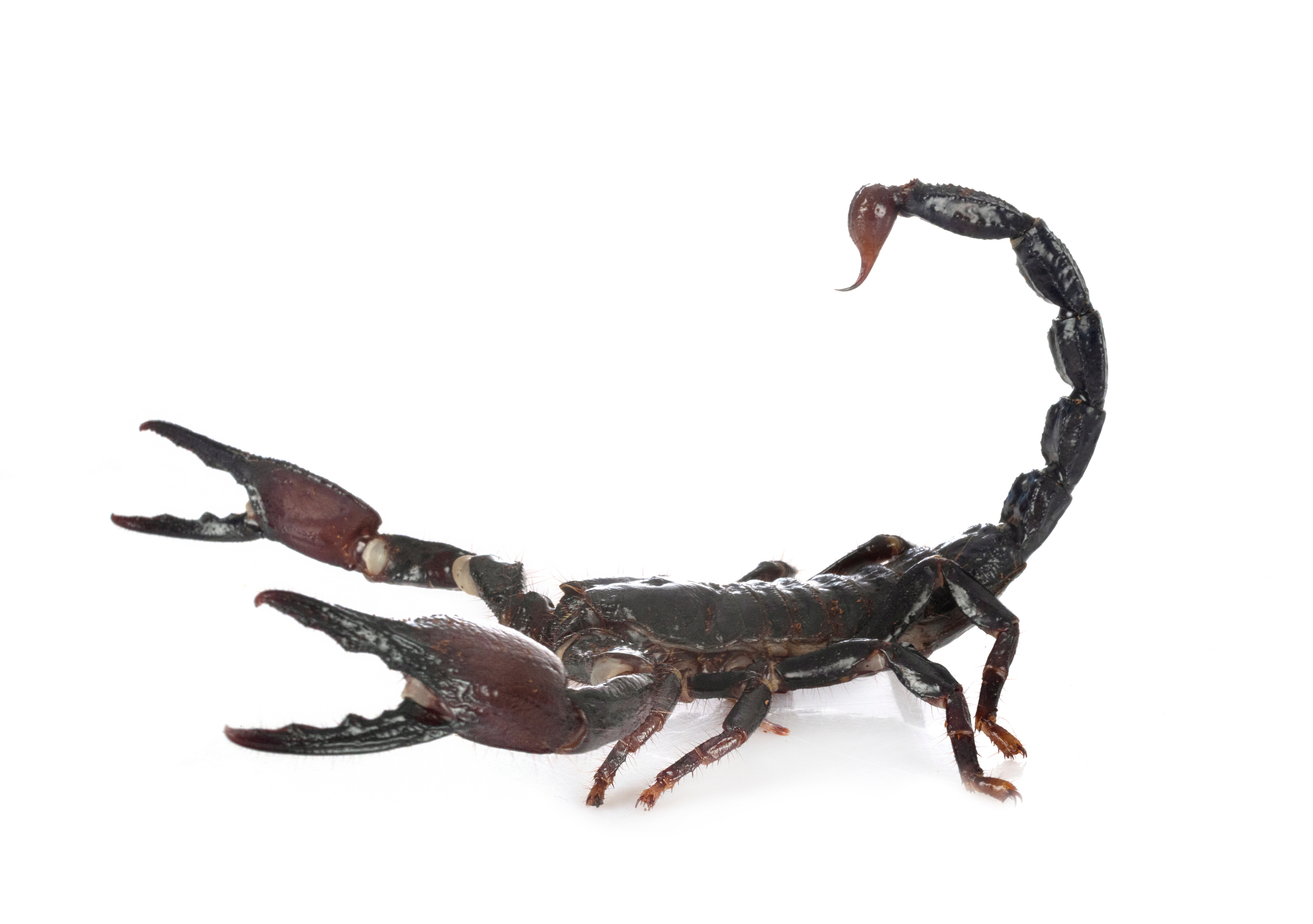
Scorpions and tarantulas are insectivores, meaning they explicitly eat insects, and they require live prey for stimulation and nutrition. Their feeding behavior is instinct-driven, and while schedules can vary by species and age, most healthy adults eat about once per week. Feeding should always be supervised and adjusted based on appetite, body condition, and life stage.
What to feed scorpions and tarantulas
Primary feeder options include:
- Gut-loaded crickets
- Dubia roaches
- Hornworms
- Mealworms (for occasional variety)
Feeder insects must be gut-loaded—that is, fed a nutrient-rich diet before being offered to your arachnid. This improves their nutritional value and supports the long-term health of your animal. Do not feed wild-caught insects. They may carry parasites or pesticide residue that could be harmful or fatal.
Feeding tips
- Feed once per week in the evening or early night
- Offer one to two appropriately sized prey items per feeding
- Prey should never exceed the length of your arachnid’s body
- Use long feeding tongs to prevent accidental strikes during feeding
- Remove uneaten prey after 24 hours to reduce stress and injury risk
Never leave uneaten prey in the enclosure if your animal does not eat. Some prey insects can bite and may irritate or injure your pet and can contribute to habitat hygiene issues. Some animals may also become stressed by the presence of prey insects in their territory.
Water and hydration
While scorpions and tarantulas rarely drink from open water, a shallow dish should always be available. It helps maintain ambient humidity and provides a water source if needed.
- Use a shallow cap or dish with a stable rim
- Refill and clean daily
- For slings or juveniles, use a moistened cotton ball or water gel cube
Avoid deep or steep-sided dishes. Drowning is rare but possible for small or weakened animals. Also consider placing small rocks in the water dish so in the event your pet did slip into the water, they can safely use the rocks to climb back out.
Understanding molting
Molting is a vulnerable and critical phase in an arachnid’s life. To grow, they must shed their external exoskeleton. Juveniles may molt several times per year, while adults molt less frequently or not at all.
Signs of pre-molt:
- Refusal to eat for several days or weeks
- Decreased movement or visible lethargy
- Increased time spent sealed in a hide or burrow
- Dull or darkening coloration
During this time, it is essential to leave your animal completely undisturbed. Do not attempt to handle, feed, or move the enclosure. Disrupting a molt can result in fatal injuries or limb loss. Do not try to assist with a molt. Even if the old exoskeleton appears stuck, attempting to pull or peel it can severely damage your animal. Maintain optimal humidity throughout the molt period. If you suspect complications after 48 to 72 hours, consult an exotic veterinarian with arachnid experience.
When to see a vet
Contact your exotics veterinarian if you notice the following signs:
- hiding more than usual
- eating or drinking less
- abdominal wounds
- difficulty molting
- reluctance to move; lost or broken limb
- hair loss
While finding a vet for arachnids is difficult, it is not impossible! There are some veterinarians within the realm of exotics who do practice medicine for our arachnid friends. Reach out to your local exotics veterinarian to find out if they can help with your pet, or even join a group for spider and scorpion husbandry! Many times people within the community will want to help, and may also have veterinarian recommendations
SHOPPING CHECKLIST
- 5-10 gallon (12-20” tall) terrarium with secure screened lid or screen enclosure
- Sphagnum moss, coconut fiber/bark and sand
- Daytime heat lamp and bulb
- Habitat thermometer(s) and hygrometer
- Artificial/natural rock or wood hiding spots
- Branches/plants for climbing and hiding
- Shallow water dish
- Crickets, dubia roaches, hornworms and mealworms
Ready to learn more? This guide is a great starting place, but we encourage you to do more research on the individual species that you are keeping so that you can be as successful as possible!
Related guides:
- Molting in Arthropods
- Setting Up a Bioactive habitat
- Feeder Insect Care & Setup
FAQs
How often should I feed my scorpion or tarantula?
Most healthy adults eat once every 7 to 10 days. Juveniles may need to eat more often, especially during growth phases. Always monitor body condition and feeding response to adjust as needed.
Most healthy adults eat once every 7 to 10 days. Juveniles may need to eat more often, especially during growth phases. Always monitor body condition and feeding response to adjust as needed.
What size prey is appropriate?
Feeder insects should be no longer than the length of your scorpion or tarantula’s body, not including legs or tail. Oversized prey can be refused or may injure your animal.
Feeder insects should be no longer than the length of your scorpion or tarantula’s body, not including legs or tail. Oversized prey can be refused or may injure your animal.
Can I feed wild insects?
No. Wild insects may carry harmful parasites or pesticide residue. Always use captive-raised feeder insects from a reliable source.
No. Wild insects may carry harmful parasites or pesticide residue. Always use captive-raised feeder insects from a reliable source.
Do they drink from water dishes?
Rarely, but a shallow water dish should still be provided at all times. It helps with humidity regulation and offers a hydration source when needed.
Rarely, but a shallow water dish should still be provided at all times. It helps with humidity regulation and offers a hydration source when needed.
How can I tell if my arachnid is preparing to molt?
Signs include a refusal to eat, reduced movement, sealing off a burrow or hide, and dull or darkening coloration. Pre-molt animals should not be disturbed.
Signs include a refusal to eat, reduced movement, sealing off a burrow or hide, and dull or darkening coloration. Pre-molt animals should not be disturbed.
What should I do during a molt?
Do not feed or handle your animal. Maintain high humidity, keep the enclosure calm, and allow at least 48 to 72 hours for recovery. If complications occur, contact a veterinarian who works with invertebrates.
Do not feed or handle your animal. Maintain high humidity, keep the enclosure calm, and allow at least 48 to 72 hours for recovery. If complications occur, contact a veterinarian who works with invertebrates.
Can I handle my scorpion or tarantula?
Handling is not recommended for most species. Some tarantulas may tolerate short periods of gentle handling, but scorpions should only be handled when absolutely necessary. Handling increases the risk of injury and stress.
Handling is not recommended for most species. Some tarantulas may tolerate short periods of gentle handling, but scorpions should only be handled when absolutely necessary. Handling increases the risk of injury and stress.
Why is my tarantula creating so much webbing?
Webbing is normal and varies by species. Arboreal tarantulas may build silk hammocks, while terrestrial species may line their hides or anchor webbing across the substrate. Increased webbing may also indicate environmental changes or pre-molt behavior.
Webbing is normal and varies by species. Arboreal tarantulas may build silk hammocks, while terrestrial species may line their hides or anchor webbing across the substrate. Increased webbing may also indicate environmental changes or pre-molt behavior.
Is it normal for my scorpion to hide all the time?
Yes. Scorpions are naturally reclusive and nocturnal. They prefer to stay hidden during the day and may only become active at night or when feeding.
Yes. Scorpions are naturally reclusive and nocturnal. They prefer to stay hidden during the day and may only become active at night or when feeding.
When should I contact a veterinarian?
Seek care if your animal has difficulty molting, shows no movement for several days outside of molt, has visible injuries or missing limbs, develops unusual color changes, or shows signs of mites or other parasites.
Seek care if your animal has difficulty molting, shows no movement for several days outside of molt, has visible injuries or missing limbs, develops unusual color changes, or shows signs of mites or other parasites.
In this Article
- Crawling Right Into Your Heart, Scorpions & Tarantulas!
- Setting up a habitat for your scorpion or tarantula
- Enclosure size and type
- Substrate and humidity control
- Temperature regulation
- Feeding and molting in scorpions and tarantulas
- What to feed scorpions and tarantulas
- Feeding tips
- Water and hydration
- Understanding molting
- SHOPPING CHECKLIST
- FAQs

